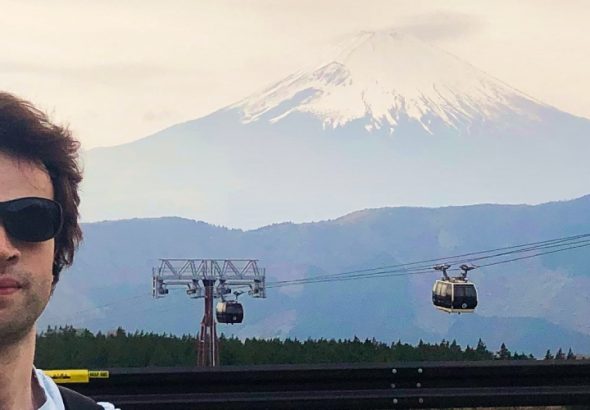# ropeway

I went on a trip to Hakone and bought the Free Pass which gave me unlimited access to a range of different modes of transport as well as a round trip back to Shinjuku. The first stop was the Open Air Museum which features all kinds of quirky art structures but the highlight was definitely the symphonic structure that is grey and plain on the inside but a wall of colour within. The Hakone ropeway is a popular form of transportation in Hakone. This mode of transport is entirely free with the Hakone free pass. However, this is more than just a means of getting from A to B (which it does a very good job in taking you to lake Ashi) as it is an experience in its own right. One moment you are sailing above the trees and the next you are over the top of the mountain ridge and looking at the face of a volcano. Also, if you go on a clear day like I did then Mount Fuji is visible enough to snatch a photo of. Immediately after getting off the ropeway you are deposited at the shores of lake Ashi where a pirate ship awaits and at times like this it genuinely felt like the halogen area was one big sightseeing assault course with tourists carried along by the different and contrasting modes of transport as if they were on a conveyor belt. In truth I didn’t think the boat ride was that impressive, in fact it was the opposite of the symphonic structure in the Hakone Open Air Museum in that it was grand on the outside but ordinary within. In fact, I was more interested in speaking with some Canadians I met than I was in the boat ride and we discussed our Japan travel experiences at length. At the end of the boat ride I had the choice to go to Hakone shrine to the north or Mishima skywalk to the south and I decided to go with the latter as it was the path less travelled. I arrived at sunset and there were views of a sunset, suspension bridge, Sakura and Mount Fuji all at once. It was raining on the second day in Hakone (and a second day is necessary if you want to see the majority of what is on offer in the area) so I went for an activity that didn’t require good weather, the Hakone Glass Museum. When I arrived it didn’t feel like much of a museum at all but rather a quaint, fancy garden with many of the trees and bushes replaced by glass. While the individual exhibits weren’t jaw dropping, but like many of the other things they came together to create a mystical and peaceful atmosphere where you could sit and relax without overwhelming hordes of tourists which made a nice change from bouncing from one tourist hotspot to another. The most underrated attraction in the Hakone area by far was Tamadare falls. So underrated that it doesn’t even feature on the area map you get with the Hakone free pass (you need Hakone Yumoto station, OH51). In fact the only reason I knew about it was because the other English person who arrived at the sharehouse the same time as me went there and I saw their pictures on Instagram. I am glad I decided to be a copycat as it was one of my favourite places. The statues of dragons spitting water, the koi fish, the crimson-leaved trees and of course the waterfall with a pond complete with stepping stones made for some really good scenery. Also, because this area is relatively off the grid you also could still feel the atmosphere of the place as it wasn’t drowned out by crowds of tourists. I was in no particular rush to head back to Tokyo and I had seen everything I wanted to see so I decided to stop by Odawara castle. I arrived at about a quarter to 5 so there was little point in me paying to go inside the castle if it was going to close in 15 minutes. However, that didn’t mean the trip was wasted at all, the castle grounds and walls on the outside were more than sufficient to get a feel of the place and get some good photos in the process. Report by our participant Jacob
